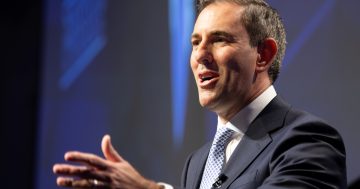Michael Janda* says that with Australia ranked second globally for household debt, restrictions on financial advertising like those applied to tobacco might be needed.
 We are bombarded with emotive ads selling debt through dreams of home ownership, new cars, tropical holidays and financial freedom or, even more dangerous, through fears of missing out while others get ahead using debt.
We are bombarded with emotive ads selling debt through dreams of home ownership, new cars, tropical holidays and financial freedom or, even more dangerous, through fears of missing out while others get ahead using debt.
Internet giant Google stopped taking ads from payday lenders, putting their products in the same category as illegal drugs, guns and tobacco.
While payday lenders are at the extreme end of the lending sector, their advertising tactics are little different to the major banks and non-bank lenders.
In fact, banks actively target children with “financial education” programs, which happen to also be great ways to acquire customers who may end up with the institution for a lifetime through customer inertia.
Westpac went as far as targeting parents with accounts for their unborn child.
But at least the products they are selling to children are savings accounts and, given low levels of household saving are a national problem, that’s probably a good thing.
The more dangerous financial advertising is that selling debt.
Tune in to the television and you also see plenty of ads for how personal loans and credit cards can help you go on holidays, buy cars and other consumer goods or pay urgent bills.
What most don’t mention, or only mention in the fine print, is how long it might take you to repay the debt, the interest you’ll end up paying and the other things you’ll have to sacrifice to do so.
Australia’s debt addiction
As a nation, Australians have focused on the apparent benefits of debt with complete disregard for the risks
That has left Australia with a big, bad debt problem.
And it’s not Government debt that’s the issue.
It is household debt that is the nation’s Achilles heel.
Australia ranks second in the world for household debt levels, at 122 per cent of GDP — that means it would take a year and 79 days of the nation’s total economic output to pay off what households owe, and that doesn’t include interest.
Why do we have so much debt?
Record low interest rates, deregulated finance that has allowed for bigger loans to more people and a national obsession with real estate have all contributed.
Unwinding some of those policy decisions would no doubt put downward pressure on household debt levels.
Aspects of these policy shifts have been canvassed, some proposed and a few enacted, with the result that Australia’s biggest housing markets are in decline as loan growth slows, which should see household debt start easing off.
But there is another idea that hasn’t been widely canvassed that could help Australians kick the debt habit.
Plain packaging for loans
In the same way that the Government banned tobacco advertising and forced the companies to show the after effects on their packaging, perhaps lenders should be made to do something similar — something akin to plain packaging.
This would allow banks and other lenders to advertise the products they have available, their interest rates and conditions, but not to use emotive messaging to sell them.
No more actors playing first-home buyers at an auction or happy couples on a holiday paid for with a personal loan.
Instead of an exclusive focus on the short-term lifestyle debt can facilitate, the ads would focus on the nature of the product — the interest rate, the term (if applicable) and the amount of repayments and interest on a standard sample loan amount.
Marketing and consumer behaviour expert Professor Paul Harrison says his own research shows how distracting and persuasive emotive imagery can be, which contributed to the banning of unsolicited credit card limit increase offers.
“Consumers did not look at the interest rates, or the details of the limit, but were drawn towards imagery, colours, and bolded statements such as ‘get a little more out of every day’, coupled with images of people watching large-screen TVs,” he explained.
Attractive woman adds 0.5 per cent to interest rates
Professor Harrison says other research shows psychological manipulation, such as the image of an attractive woman in a loan advertisement, had a positive effect that was the equivalent to a 0.5 percentage point drop in the interest rate.
This works by exploiting the “peripheral route” to persuasion.
“By removing the peripheral stimuli, the consumer is more likely to consider the critical information,” he says.
Although he adds that they may still not understand it, even if they consider it.
Financial ads that don’t exploit our psychological vulnerabilities might even comply with Australian Securities and Investment Commission (ASIC) guidelines: “We encourage promoters to create advertisements that not only meet the minimum requirement of not being misleading or deceptive but that also help consumers make appropriate decisions.”
“Balance is important for ensuring that the overall effect of an advertisement creates realistic expectations about a product.”
Evidence from the early years of tobacco plain packaging shows such moves do have an impact — the combination of plain packaging and graphic health warnings led to a statistically significant decline in smoking.
A ban on emotive debt advertising could reasonably be assumed to have some effect on the take up of credit.
Vested interests in retaining financial ads
But such restrictions are incredibly unlikely to happen.
Tobacco companies fought tooth and nail against plain packaging, even unsuccessfully suing the Australian Government.
The most dangerous opposition confronting any government considering such advertising restrictions is not necessarily from the companies selling the products.
According to data from Standard Media Index (SMI), domestic banks spent $78 million on advertising across various media platforms during the first three months of this year, with industry figures estimating that a similar amount again is paid directly to media companies.
This means banks could be paying media companies more than $600 million a year for advertising slots.
It’s a large pool of money that Australia’s struggling media companies can’t afford to lose.
So, one wouldn’t expect to see this idea gain a lot of traction.
* Michael Janda is the ABC’s senior digital business reporter. He tweets at @mikejanda.
This article first appeared at www.abc.net.au.











